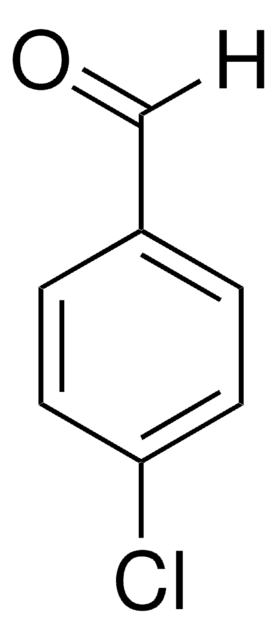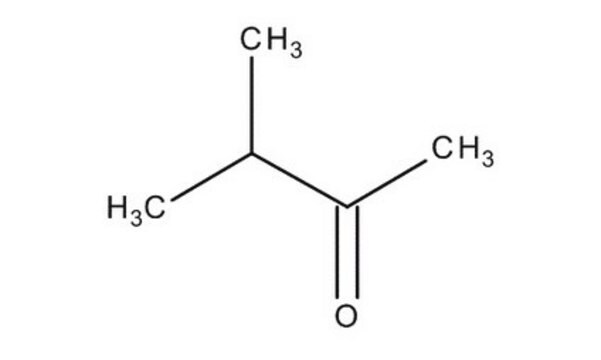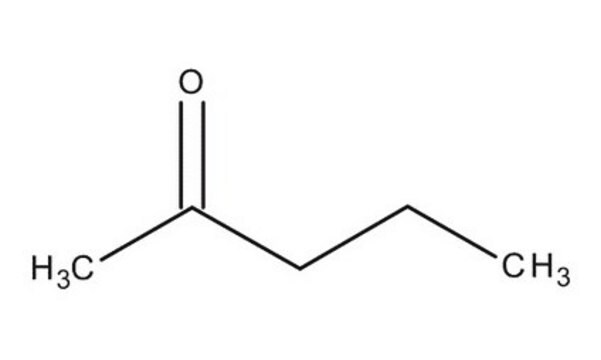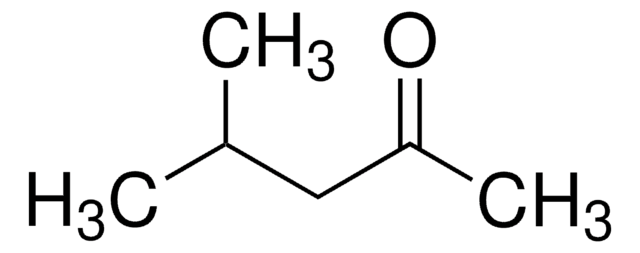8.03605
Diethyl ketone
for synthesis
Sinónimos:
Diethyl ketone, 3-Pentanone, Ethyl ketone
About This Item
Productos recomendados
presión de vapor
37.6 hPa ( 20 °C)
Nivel de calidad
Ensayo
≥99% (GC)
Formulario
liquid
temp. de autoignición
425 °C
potencia
2900 mg/kg LD50, oral (Rat)
16200 mg/kg LD50, skin (Rabbit)
lim. expl.
1.6-7.7 % (v/v)
dilution
(for synthesis)
pH
6.2 (20 °C, 50 g/L in H2O)
bp
101-103 °C/1013 mbar
mp
-40 °C
temperatura de transición
flash point 7 °C
solubilidad
50 g/L
densidad
0.81 g/cm3 at 20 °C
temp. de almacenamiento
2-30°C
cadena SMILES
O=C(CC)CC
InChI
1S/C5H10O/c1-3-5(6)4-2/h3-4H2,1-2H3
Clave InChI
FDPIMTJIUBPUKL-UHFFFAOYSA-N
Aplicación
- Resonance Stabilization Effects on Ketone Autoxidation: Isomer-Specific Cyclic Ether and Ketohydroperoxide Formation in the Low-Temperature (400-625 K) Oxidation of Diethyl Ketone.: This study examines the low-temperature oxidation of diethyl ketone, highlighting how resonance stabilization influences the formation of specific cyclic ethers and ketohydroperoxides, vital for understanding combustion mechanisms and environmental implications of ketone use in industrial applications (Scheer AM et al., 2016).
- Low-temperature combustion chemistry of novel biofuels: resonance-stabilized QOOH in the oxidation of diethyl ketone.: This research focuses on the combustion chemistry of diethyl ketone as a biofuel, providing insights into the formation of resonance-stabilized QOOH intermediates which are crucial for developing more efficient and cleaner burning fuels (Scheer AM et al., 2014).
- Wet effluent diffusion denuder technique and determination of volatile organic compounds in air. I. Oxo compounds (alcohols and ketones).: Explores the use of diethyl ketone in air quality monitoring, employing a novel wet effluent diffusion denuder technique for the sensitive detection of oxo compounds, vital for environmental monitoring and regulatory compliance (Pesková J et al., 2001).
- Identification limits for volatile organic compounds in the blood by purge-and-trap GC-FTIR.: Discusses the detection limits of volatile organic compounds, including diethyl ketone, in blood using advanced purge-and-trap gas chromatography coupled with Fourier-transform infrared spectroscopy, emphasizing its importance in forensic and toxicological analyses (Ojanperä I et al., 1998).
Nota de análisis
Density (d 20 °C/ 4 °C): 0.813 - 0.815
Identity (IR): passes test
Palabra de señalización
Danger
Frases de peligro
Consejos de prudencia
Clasificaciones de peligro
Eye Irrit. 2 - Flam. Liq. 2
Riesgos supl.
Código de clase de almacenamiento
3 - Flammable liquids
Clase de riesgo para el agua (WGK)
WGK 1
Punto de inflamabilidad (°F)
44.6 °F
Punto de inflamabilidad (°C)
7 °C
Certificados de análisis (COA)
Busque Certificados de análisis (COA) introduciendo el número de lote del producto. Los números de lote se encuentran en la etiqueta del producto después de las palabras «Lot» o «Batch»
¿Ya tiene este producto?
Encuentre la documentación para los productos que ha comprado recientemente en la Biblioteca de documentos.
Los clientes también vieron
Nuestro equipo de científicos tiene experiencia en todas las áreas de investigación: Ciencias de la vida, Ciencia de los materiales, Síntesis química, Cromatografía, Analítica y muchas otras.
Póngase en contacto con el Servicio técnico











